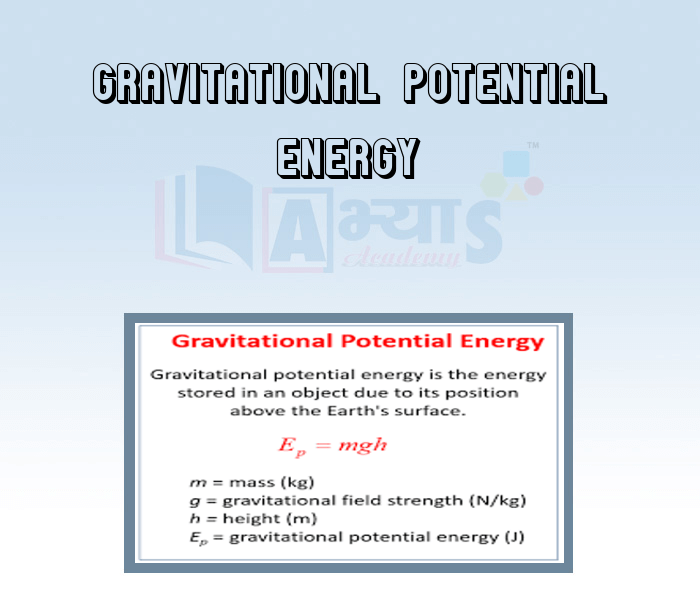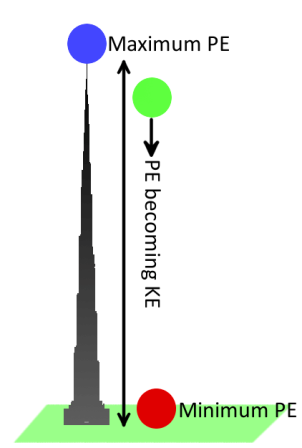Gravitational Potential Energy











Gravitational Potential Energy
Gravitational Potential Energy :
The energy possessed by an object due to its height is known as gravitational potential energy. When an object is raised through a certain height above the ground, its energy increases.This is because the work is done on it against gravity while it is moving upwards. Similarly when an object is allowed to fall from higher level to a lower level it gains speed due to gravitational pull, i.e., it gains kinetic energy. Therefore, as the distance of the object from the ground level is increasing, the body is converting its kinetic energy into potential energy. The magnitude of its gravitational potential energy is equivalent to the amount of work done by the weight of the body in causing the fall.
Expression for Potential Energy:
If a mass m is at a height h above a lower level, the P.E. possessed by the mass is given by the equation
PE = mgh
Since h is the height of an object above a specified level, an object below the specified level has negative potential energy.
We know that energy in a body is due to its position is defined as the energy stored in the body. If position of the body changes with the application of the external force the change in potential energy is equal to the amount of work done on the body by the forces.

Consider an object lying at the ground. Here the potential energy is zero and its weight is acting downwards.
As the object is placed at a height h above the groun d level we have to apply minimum force mg equal to the weight of the object.
Thus work is being done against gravity is being converted into to potential energy
Work done = Force X displacement
W = F X s
As force F = mg
displacement s = h
Therefore, W = mg X h
PE = mgh
The energy results from the force of attraction mg between the earth and the object. From Newton's third law of motion, the earth and the object attract each other. In actual we can say that the energy mgh is not the potential energy of the object alone - it is the energy of the object- earth system.
An object can have different potential energy with respect to different height.. Thus potential energy of an object is a relative term as it depends on the height between the two objects.
Illustration: Calculate height through which the object of mass 1 Kg we raised so that it gains a potential energy of 98 J.
Solution:Given
mass m = 1 Kg
PE = 98 J
h = ?
Height can be calculated using the expression for the potential energy
PE = mgh
An object of mass 1kg has a P.E. of 1 J relative to the ground when it is at a height of | |||
| Right Option : A | |||
| View Explanation | |||
A total of 9800 joule was consumed in lifting a 50 kg mass.The mass was raised to a height of _____________. | |||
| Right Option : C | |||
| View Explanation | |||
The work done in lifting a mass of 1 kg to a height of 9.8 m is | |||
| Right Option : B | |||
| View Explanation | |||
Students / Parents Reviews [20]
My experience with Abhyas Academy has been very good. When I was not in Abhyas whenever teacher ask questions I could not speak it confidently but when I came in Abhyas, my speaking skills developed and now I am the first one to give the answer of teachers question.

Upmanyu Sharma
7thUsually we see institutes offering objective based learning which usually causes a lag behind in subjective examinations which is the pattern followed by schools. I think it is really a work of planning to make us students grab the advantages of modes of examination, Objective Subjective and Onli...

Anika Saxena
8thWhen I have not joined Abhyas Academy, my skills of solving maths problems were not clear. But, after joining it, my skills have been developed and my concepts of science and SST are very well. I also came to know about other subjects such as vedic maths and reasoning.

Sharandeep Singh
7thAbhyas institute is one of the best coaching institute in the vicinity of Ambala cantt.The institute provides good and quality education to the students.The teachers are well experienced and are very helpful in solving the problems. The major advantages of the institute is extra classes for weak...

Shreya Shrivastava
8thMy experience with Abhyas academy is very nice or it can be said wonderful. I have been studying here from seven class. I have been completing my journey of three years. I am tinking that I should join Abhyas Academy in tenth class as I am seeing much improvement in Maths and English

Hridey Preet
9thAbhyas Methodology is very good. It is based on according to student and each child manages accordingly to its properly. Methodology has improved the abilities of students to shine them in future.

Manish Kumar
10thAbhyas is good institution and a innovative institute also. It is a good platform of beginners.Due to Abhyas,he has got knoweledge about reasoning and confidence.My son has improved his vocabulary because of Abhyas.Teacher have very friendly atmosphere also.

Manish Kumar
10thA marvelous experience with Abhyas. I am glad to share that my ward has achieved more than enough at the Ambala ABHYAS centre. Years have passed on and more and more he has gained. May the centre flourish and develop day by day by the grace of God.

Archit Segal
7thThe experience was nice. I studied here for three years and saw a tremendous change in myself. I started liking subjects like English and SST which earlier I ran from. Extra knowledge gave me confidence to overcome competitive exams. One of the best institutes for secondary education.

Aman Kumar Shrivastava
10thAbhyas is a complete education Institute. Here extreme care is taken by teacher with the help of regular exam. Extra classes also conducted by the institute, if the student is weak.

Om Umang
10thAbhyas institute is one of the best coaching institute in the vicinity of Ambala Cantt area. The teachers of the institute are well experienced and very helpful in solving the problems of the students.The good thing of the institute is that it is providing extra classes for the students who are w...

Aman Kumar Shrivastava
10thMy experience with Abhyas is very good. I have learnt many things here like vedic maths and reasoning also. Teachers here first take our doubts and then there are assignments to verify our weak points.

Shivam Rana
7thAbhyas academy is great place to learn. I have learnt a lot here they have finished my fear of not answering.It has created a habit of self studying in me.The teachers here are very supportive and helpful. Earlier my maths and science was good but now it has been much better than before.

Barkha Arora
10thOne of the best institutes to develope a child interest in studies.Provides SST and English knowledge also unlike other institutes. Teachers are co operative and friendly online tests andPPT develope practical knowledge also.

Aman Kumar Shrivastava
10thAbout Abhyas metholodology the teachers are very nice and hardworking toward students.The Centre Head Mrs Anu Sethi is also a brilliant teacher.Abhyas has taught me how to overcome problems and has always taken my doubts and suppoeted me.

Shreya Shrivastava
8thIt has a great methodology. Students here can get analysis to their test quickly.We can learn easily through PPTs and the testing methods are good. We know that where we have to practice

Barkha Arora
10thWe started with lot of hope that Abhyas will help in better understnding of complex topics of highers classes. we are not disappointed with the progress our child has made after attending Abhyas. Though need to mention that we expected a lot more. On a scale of 1-10, we would give may be 7.

Manya
8thIn terms of methodology I want to say that institute provides expert guidence and results oriented monitering supplements by requsite study material along with regular tests which help the students to improve their education skills.The techniques of providing education helps the students to asses...

Aman Kumar Shrivastava
10thMy experience with Abhyas academy is very good. I did not think that my every subject coming here will be so strong. The main thing is that the online tests had made me learn here more things.

Hiya Gupta
8thIt was good as the experience because as we had come here we had been improved in a such envirnment created here.Extra is taught which is beneficial for future.
